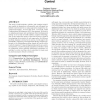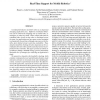138 search results - page 19 / 28 » Evolved Neurodynamics for Robot Control |
GECCO
2005
Springer
14 years 4 months ago
2005
Springer
The need to build modular, scalable, and complex technology capable of adaptation, self-assembly, and self-repair has fuelled renewed interest in using approaches inspired by deve...
ICRA
1994
IEEE
14 years 3 months ago
1994
IEEE
The Self-Mobile Space Manipulator (SM2) has evolved to adapt to the new pre-integrated I-beam structure of the Space Station Freedom (SSF). In this paper, we first briefly overvie...
ICRA
2009
IEEE
2009
IEEE
Temporal stabilization of discrete movement in variable environments: An attractor dynamics approach
13 years 8 months ago
The ability to generate discrete movement with distinct and stable time courses is important for interaction scenarios both between different robots and with human partners, for ca...
ICRA
2007
IEEE
14 years 5 months ago
2007
IEEE
— Consider a biped evolving in the sagittal plane. The unexpected rotation of the supporting foot can be avoided by controlling the zero moment point or ZMP. The objective of thi...
RTAS
2003
IEEE
14 years 4 months ago
2003
IEEE
Coordinated behavior of mobile robots is an important emerging application area. Different coordinated behaviors can be achieved by assigning sets of control tasks, or strategies,...



